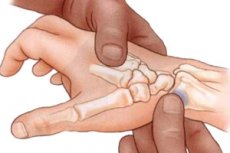Medical expert of the article
New publications
Joint diagnostics
Last reviewed: 05.07.2025

All iLive content is medically reviewed or fact checked to ensure as much factual accuracy as possible.
We have strict sourcing guidelines and only link to reputable media sites, academic research institutions and, whenever possible, medically peer reviewed studies. Note that the numbers in parentheses ([1], [2], etc.) are clickable links to these studies.
If you feel that any of our content is inaccurate, out-of-date, or otherwise questionable, please select it and press Ctrl + Enter.

First of all, when questioning, they find out whether the patient has any possible complaints about pain in certain joints, which may be constant or, for example, fleeting (i.e., quickly disappear in one joint and appear in another), arise independently or with movement. They must clarify whether the patient experiences morning stiffness in the joints, whether he notes limited movement in certain joints (stiffness) and the presence of crunching when moving the joints, etc.
The examination of the joints is carried out with the patient in various positions (standing, sitting, lying down, and also while walking), while observing a certain order. First, the condition of the joints of the hand is assessed, then they move on to examining the elbow and shoulder joints, the temporomandibular joint, the cervical, thoracic and lumbar spine, the sacroiliac joints, the sacrum and coccyx, the hip and knee joints, and the joints of the foot. The results obtained from examining each of the symmetrical joints are necessarily compared with each other.
Inspection and palpation of joints
During examination, attention is paid to changes in the configuration of the joints (for example, an increase in their volume, spindle-shaped form), smoothing of their contours, and changes in the color of the skin over the joints (hyperemia, shine).
Palpation of the joints can better reveal their swelling, which can be caused by both the presence of effusion in the joint cavity and inflammatory edema of the periarticular tissues. Accumulation of free fluid in the joint cavity is also confirmed by the appearance of fluctuation in such cases - a sensation of oscillation (fluctuation) of the fluid upon palpation. The symptom of ballotturation of the patella is especially indicative in this regard. To detect it, the patient is laid horizontally with the lower limbs maximally extended. The thumbs are placed on the patella, and the lateral and medial areas of the knee joint are squeezed with the palms of both hands. Then, with the thumbs, push the patella in the direction of the anterior surface of the articular end of the femur. If there is free fluid in the cavity of the knee joint, the fingers feel a weak response push caused by the impact of the patella on the surface of the femur.
In the process of diagnosing joints, attention is also paid to the presence of pain when palpating them. For this, careful, but at the same time deep enough palpation is used, covering one or another joint with two fingers (thumb and index). In cases of active inflammatory process in the joints, local increase in skin temperature over the area of the affected joints can also be detected during palpation. For this purpose, the back of the hand is applied to the skin over the corresponding joints. The data obtained in this way are compared with the skin temperature over a symmetrical healthy joint. If a symmetrical joint is also involved in the pathological process, then the results of determining the skin temperature are compared with the data obtained when examining the skin temperature over other unchanged joints. Using a centimeter tape, the circumference of symmetrical joints, for example, the shoulder, elbow, wrist, knee, ankle, is also measured.
Of great importance in the diagnosis of various joint diseases is the determination of the volume of active and passive movements performed in various joints, the identification of stiffness, and pain during movement. In this case, the active movements are performed by the patient himself, and the passive ones (flexion, extension, abduction, adduction of the limb) are performed by the doctor with complete relaxation of the patient's muscles.
When performing a particular movement in the joints, a certain angle is formed, which can be measured if necessary. For example, the absolute mobility of the knee joint during flexion should be about 150°, the ankle - 45°, the hip - 120°, etc. More accurate data on the mobility of various joints can be obtained using special devices - goniometers, which are a graduated semicircle, to the base of which a movable and fixed branch is attached. When the movable branch moves synchronously with the movement of the limb, angles of different sizes are formed, marked on the goniometer scale.
When ankylosis of joints (fusion of articular surfaces) develops, crunching or crepitation can sometimes be detected during their movement, which becomes more distinct for perception in cases where the doctor's palm is placed on the corresponding joint. When auscultating the joints, friction noise of the intra-articular surfaces of the epiphyses can be heard.
In the absence of any pathological changes, this section is presented in the medical history in a fairly concise manner. For example, the following description is possible:
Examination (diagnostics) of joints
There are no complaints. On examination, the joints are of normal configuration. The skin above them is of normal color. When palpating the joints, their swelling and deformation, changes in periarticular tissues, and pain are not noted. The range of active and passive movements in the joints is fully preserved. There is no pain, crunching, or crepitus when moving. Further (preferably in the form of a table), the circumference of symmetrical joints in cm (shoulder, elbow, wrist, knee, ankle) is noted.
Having completed the general examination, they move on to a direct examination of the main systems of the body: respiration, circulation, digestion, etc. The specifics of using various methods of direct examination of individual systems of the body will be consistently outlined in subsequent chapters.


 [
[